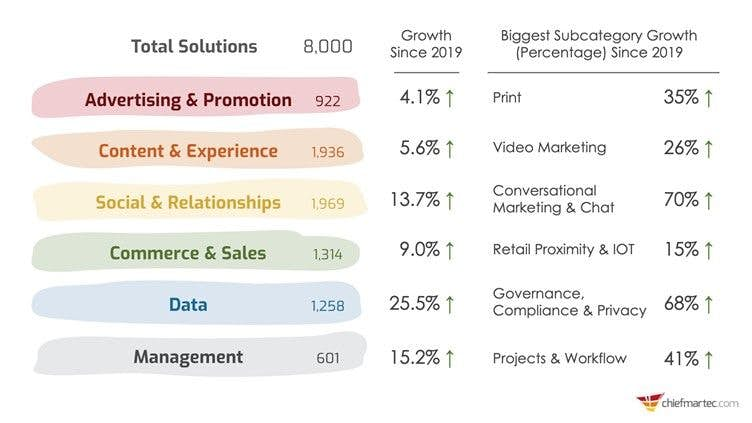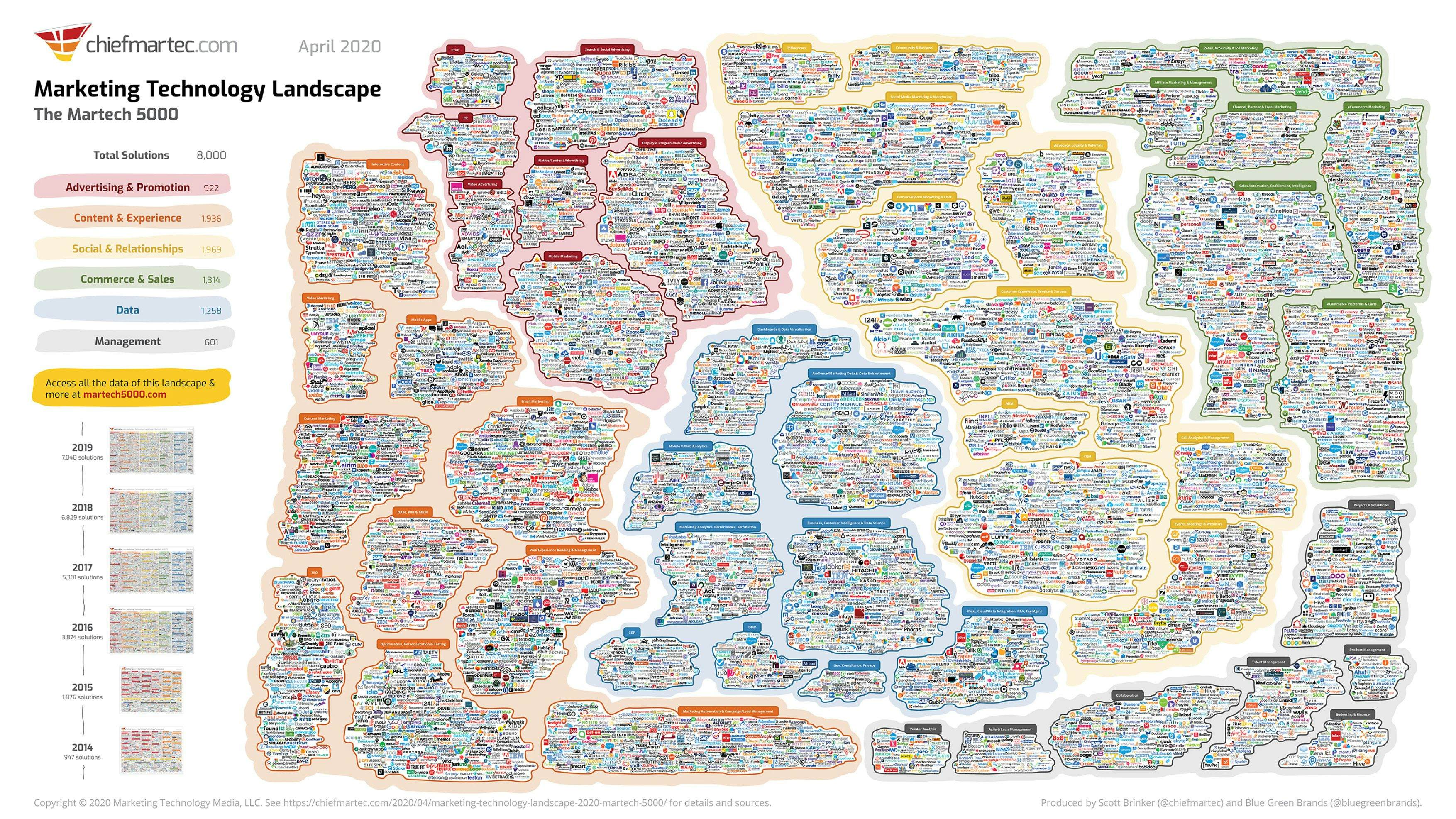Blog
Marketing Data and Analytics in 2020: A failed promise and how to fix the issue
May 14, 2021 | Chris Kervinen

Earlier this month Gartner published the results of its survey of 415 marketing leaders and analytics practitioners , revealing the leading reasons why analytics are not utilized in crucial marketing decisions. The growing investments in analytics don’t seem to live up to the hype.
Majority of senior marketing executives are not happy with the results they get from their marketing data and analytics investments. Up to 54% of the senior respondents in Gartner’s survey told that the new marketing analytics initiatives had not led to expected changes in the organization, let alone concrete business impact.
At the same time the marketing technology industry is booming; there’s now more than 8,000 martech solutions, which means +13,6% increase from last year (+24,5% increase if you take into account 615 companies that don’t exist anymore). The fastest-growing category is Data (+25,5%) by far:

The Marketing Technology landscape is growing fast year after year, with data being the biggest current trend. Statistics and image by Chiefmartec .
So, we have more and more solutions to harness the ever-growing amount of data, but majority of these “solutions” don’t provide actual value for the customer.
This creates (with a growing trend) problems in two distinctive ways:
1. The marketing analytics industry becomes bloated with empty promises
2. Marketers will have harder time to differentiate the better service providers from bad ones
The situation might not seem so dire, but it is. Because when you can’t trust the results, you end up making decisions based on gut-feeling (and your expertise, of course). Which is what the Gartner survey also found out: 46% of the marketing decisions are not influenced by the analytics.
So almost half of the marketing decisions are based on intuition, rather than insight. In 2020. When even the videos we watch, playlists we listen to and dates we go on are based on analytics to some degree. Which is unbearable.
Note that it’s mostly not the marketers’ fault, but rather the solution providers’ inability to deliver concrete, actionable & trustworthy results.
This is often a result of insufficient data science expertise combined with too much automation, and what the client actually gets is a shallow data visualization software – instead of answers to questions like what’s the Marketing ROI for this campaign or how to do better in the next one.
Of course the marketers are not without fault themselves, as the survey points out; 32% of the respondents disclosed that the reason why analytics weren’t utilized in the decisions was due to the findings being in conflict with current roadmap. Which is like ignoring your navigator and driving off the cliff (if we exaggerate things a bit).

Confirmation bias can lead us to neglect clear changes and go with the intuition – often with fatal consequences. Comic by Guy & Rodd
So how can we fix this issue?
Doubling down on data science and campaign analytics
Providing holistic, actionable recommendations & intuitive market insight gathering skills remain the top reasons why marketing analytics aren’t implemented in the crucial decision-making process.
Although the marketing analytics investments are on the rise (83% of the respondents plan to invest more in the analytics in future), the focus and prioritization seems a bit off with the main emphasis on the web and mobile analytics and customer analytics.
And although web, mobile and customer analytics are important, they are already really close to meeting the expectations of the senior executives, whereas data science & campaign analytics lack behind. And that’s where the biggest growth potential lies.
Here’s how you can ensure that the future marketing analytics develop to the right direction:
1. See the big picture.
By pursuing comprehensive marketing effectiveness optimization (budget allocation, promotion effectiveness, pricing etc.), companies are able to extract more value out of the investments (instead of tinkering e.g. online activities to the infinity and beyond)
2. Get impactful insight
2nd biggest impediment hindering analytics teams’ success was inability to connect data and analytics to business value. Develop in-house team that understands how to support C-level decision making, or acquire a partner that truly understands your business, needs and what kind of insights the managers and directors need in their day-to-day work
3. Build strategic partners
Whether you’re keeping things in-house or investing in external capabilities, it’s important to position the analytics team as a strategic partner to the CMO, instead of data mangers or dashboard creators. Because what’s the reason to get insights if you’re not implementing them in action?
Finding the right tool for the job
As Chiefmartec’s graphic shows, there’s an abundance of solutions for any business problem marketers are facing today. But as Gartner’s survey points out, the growing quantity of different options doesn’t supplement the quality of these tools. So how companies can differentiate superficially similar offerings?

With the amount of different Martech solutions, it's almost impossible to differentiate one from the other. Visuals by Chiefmartec
The key factor in determining each tool’s applicability and business impact potential is data science. Why? Because data science-oriented team is more likely to solve the data quality issues properly (rather than just make-do with available data) and have overall objective/unbiased perspective to the challenge at hand.
How? In contrary to consultants and media people, data scientists build everything around the data. They know what kind of data is needed, how to build the algorithms based on the task and seldomly have any strong preconceptions about possible variables.
Another just as important factor is the track record (especially if you’re looking for external partners).
How many public case studies with concrete business results does the solution provider have? Most companies like to decorate their websites with logo carousels, but it’s the customer testimonials combined with concrete business results that truly help you to define whether a solution provider can deliver on those promises.
To summarize, here’s the two things you need to check when screening the providers:
1. Talent capital
How many actual data scientists the company has? Or are there just handy programmers with their flashy UI & talented project managers who make the results sound good?
2. Impact capital
How much business impact has the company provided for its clients? Usually an excellent indicator of customer satisfaction is the amount of public case studies with concrete business results divided by the company size. Companies with zero public, identifiable case studies with concrete business results have probably benefitted more of their clients than the clients have benefitted from them.
Talking about real business impact, our most recent case study, Cloetta, came out less than a month ago! Why won't you read it through?
Curious to learn more? Book a demo.
Related articles
Read more postsNo items found!